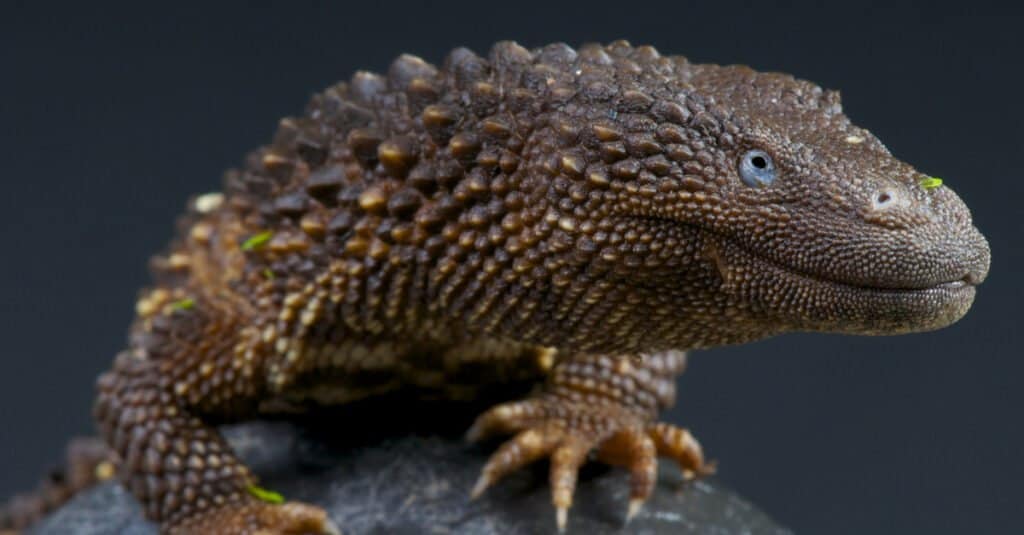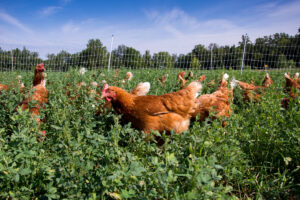Before Buying a Pet Monitor Lizard
Monitor lizards are large reptiles requiring a high level of care. They need a spacious habitat, warm environment, and a special diet. If you’re considering taking in a monitor lizard as a pet, you need to be aware of all of the care this reptile requires.
RELATED: 12 Incredible Monitor Lizard Facts!
There are many types of monitor lizards including the Savannah, Ackie, Black throat, and Nile monitor. The cost of a monitor lizard ranges from $100 to $3,000. Some types like the blue tree monitor tend to be more expensive than the Nile or Savannah monitor lizards.
A monitor lizard needs an enclosure measuring six feet long and two feet wide. It should have a screen lid to allow the heat from its lamps to flow into the cage. This pet needs a large enclosure because adults can reach a length of four or five feet long. A few types of monitor lizards need an even larger enclosure. As an example, the popular Savannah monitor lizard grows to be five feet long as an adult. Enclosures range in cost from $800 to $1500.
Having an enclosure of this size means you must make sure you have enough space in your home to accommodate it. These pets also need a variety of supplies including two heat lamps, a thermostat, a hygrometer, a warming pad, substrate (bedding), water bowl, food bowl, enclosure décor and food.
As you see, this is a pet that requires an investment of both time and money.

How Much Does a Monitor Lizard Cost?
Depending on the type of monitor lizard you choose these reptiles cost between $100 to $3,000. Generally, the larger the monitor lizard, the more expensive it will be. An enclosure for this pet has to accommodate its large size. It should be made with a wire top to allow for air circulation and access to the heat lamps. The price of an enclosure for this pet is $800 to $1,500.
In their native habitat, these lizards bask in the sun for long periods of time. So, as pets, they need to live in an enclosure with a temperature ranging from 95 to 100 degrees Fahrenheit during the day. At night, they need their enclosure to be cooler at 75 to 85 degrees Fahrenheit. This temperature change mimics what they encounter in the wild.
It needs a basking area in its enclosure that exposes it to a temperature between 110 and 130-degrees Fahrenheit. So, it requires both a heat lamp and a basking lamp along with a thermostat to ensure proper temperature.
A warming pad beneath the enclosure can be used to maintain a cooler night temperature for this lizard. A heat lamp costs around $50 while a basking lamp is around $20. A warming pad is around $50 and a thermostat costs around $40.
A hygrometer is needed to make sure this pet has the proper amount of humidity in its enclosure. A hygrometer costs around $4.
Did you know that monitor lizards love to dig? They do! This is why they need one to two feet of substrate (bedding) in their enclosure. Loose coconut fiber is a favored substrate of monitor lizard owners. It’s easy for these reptiles to dig in and it’s absorbent. This substrate is priced from $30 to $40 a bag. This material is packed tightly into bags and expands when taken out.
Your monitor lizard needs a water bowl and a food bowl. The water bowl is there for hydration and creates a humid environment. Your monitor lizard is also likely to climb into the water to cool itself. A pair of bowls is around $50.
Décor for your monitor lizard’s enclosure isn’t there simply to make it feel at home. Your lizard needs a place to bask under the heat lamp as well as places to hide. A reptile cave large enough for your monitor lizard as well as a hollow log and some artificial plants are all basic items of enclosure décor. The price of a reptile cave is from $30 to $50 while a hollow log is around $50. Three plants would add up to a total cost of $40 to $50 depending on their type.
Some people put items from their yard into their monitor lizard’s enclosure. A few large, flat rocks are good options, but be sure to thoroughly clean them.
These reptiles are carnivores. Adult monitor lizards eat one mouse a week. You can buy dead mice frozen in boxes of ten. They also eat insects like crickets, mealworms, and roaches. Frozen mice and live insects are available online. A box of ten frozen mice costs around $20. A supply of 500 live insects is around $30. You can make insects a one-time expense by breeding them in your home.
Initial Costs:
- Monitor lizard-$100
- Enclosure-$800
- Heat lamp-$50
- Basking lamp-$20
- Warming pad-$50
- Thermostat-$40
- Hygrometer-$4
- Substrate-$30
- Food and water bowls-$50
- Reptile cave-$30
- Hollow log-$50
- Artificial plants (3)-$40
- Insects-$30
- Frozen mice-$20
Total initial costs:$1,314
Ongoing costs:
- Substrate-$30 (monthly)
- Food-Supply of frozen mice (every two months)-$20
- Mobile veterinary visit (yearly)-$75
Total yearly ongoing costs: $555
Total over 20-year lifetime of a monitor lizard: $12,414
As a note, replacing necessary items of equipment is likely to be required over the life of your lizard.
New Owner Shopping List: What to Buy
Buying all of the supplies for a monitor lizard before bringing it home is a good idea. This includes its enclosure, heating equipment, substrate, bowls, décor, and food.
- Enclosure – Some types of enclosures require assembly. So, putting the enclosure together is definitely something you want to do before your lizard arrives home.
- Heat lamp – Set up this lamp so its UV rays flow through the top of the enclosure. Test this lamp to ensure it maintains a temperature of 95 to 100 degrees Fahrenheit in your pet’s habitat.
- Basking lamp – This is a lamp positioned above a log or pile of rocks where your monitor lizard can spend time in 110 to 130 degrees Fahrenheit temperatures.
- Warming pad – This is positioned beneath the enclosure in one area of the cage. It should maintain a temperature of 75 to 85 degrees Fahrenheit. This is the cooler area where your lizard can sleep at night. (The heating and basking lamps are turned off at night.)
- Thermostat – This is a very important item of equipment for your monitor lizard’s habitat. It lets you whether the temperature in the enclosure is being maintained. Proper habitat temperatures are vital to the health of this pet.
- Hygrometer – The level of humidity in your pet’s cage is important. These reptiles need 40 to 50 percent humidity in their habitat.
- Substrate – One to two feet of loose coconut fiber is necessary for this lizard’s enclosure.
- Food and water bowls – These are sturdy bowls that stay in place in your pet’s habitat. The water bowl is deep enough for your pet to crawl into to cool off.
- Reptile cave – This is a piece of décor made of non-toxic material that your pet can crawl into and hide.
- Hollow log – Your pet can sit atop this décor or crawl inside it.
- Artificial plants – Your lizard can hide behind non-toxic, artificial plants, and they add a natural look to the enclosure.
- Food – Having a supply of frozen mice and live insects ready for your monitor lizard is going to help your pet adjust to its new habitat.
Ongoing Needs: What You Need to Care for Your Monitor Lizard
Substrate, food, and vet care are all ongoing needs for this pet.
- Substrate – Loose coconut fiber is a good substrate for a monitor lizard. It’s great for digging and it absorbs waste. This pet needs one to two feet of substrate in its enclosure.
- Food – Frozen mice are a part of your lizard’s diet and need to be purchased online every two months.
- Mobile veterinary care – Yearly veterinary care is an ongoing need to keep this pet healthy and happy. Because of this reptile’s size it’s best to arrange for care from a mobile veterinarian who travels to your home.
Exercise and Ongoing Care
Exercise is necessary for most pets and the monitor lizard is no exception. These lizards like to swim so that plays a big part in their exercise regimen. Cleaning its enclosure on a regular basis contributes to the good health of your pet as well.
Exercising Your Pet
An hour of exercise a day is good for the health of this reptile. They need to be in an enclosed space free of any other pets. A small garden is a good choice especially if you can put out a plastic swimming pool. Fill it halfway up with warm water and allow your monitor lizard to play in it. Be sure to keep watch over your pet as it exercises and take note of the outdoor temperature.
Cleaning Its Enclosure
This pet’s enclosure needs two different levels of cleaning. Twice a week it’s necessary to spot clean. This entails removing all damp substrate and replacing it with fresh bedding. The goal is for your monitor lizard to avoid ever sitting in damp substrate.
Every two months, remove all of the substrate from the enclosure. Take out the food bowls, rocks, hollow log, reptile cave and other décor to scrub with mild soap and warm water. Make sure all of the items are thoroughly dry before putting them back on the fresh substrate.
It’s best to allow your monitor lizard some supervised exercise while you thoroughly clean its enclosure.
Feeding Your Monitor Lizard
The frequency, type, and amount of food you give your pet depends on its age and health status.
Babies and juvenile monitor lizards eat five to seven times a week. Monitor lizards of this age eat mostly gut-loaded insects. Gut-loaded insects are fed foods with lots of calcium so those nutrients are passed to the lizard.
Since they eat five to seven times each week, it’s normal to feed a young lizard one or two crickets or mealworms each feeding period.
Adult monitor lizards usually eat once per week. A typical diet consists of one dead mouse along with two or three live insects. Mice can be purchased frozen and should be thawed before putting it into the food bowl of this pet.
It’s important for an owner to adjust the diet of a monitor lizard if it begins to gain extra weight. Extra weight on a monitor lizard can cause lots of health issues. Try to feed your monitor lizard at the same time each week. This helps get the reptile into a familiar routine.
How Long Will Your Monitor Lizard Live?
One particularly important point to remember is monitor lizards can live as long as 20 years. Some live longer! So, they are suitable pets for people who want to dedicate themselves to caring for a pet long-term.
These lizards are hardy and can live a long, happy life if given the right living environment and fed the proper diet.
Common Health Issues for Monitor Lizard
Monitor lizards can suffer from parasitic infections. Some signs of this type of infection are lack of appetite and sluggish behavior. They may also get external parasites like mites.
Fortunately, a reptile vet can treat a parasitic infection. If you notice any of these symptoms it’s best to call the mobile vet for a checkup right away.
Where to Buy Your Monitor Lizard
It’s best to purchase a monitor lizard from an experienced breeder. Normally, they sell babies, juvenile, and adult lizards of many types.
Be sure to ask questions about the care and overall health of the lizards in their inventory. It’s even better if you can tour the breeder’s facility to see for yourself how clean and well-kept it is. Responsible breeders provide a container to transport your new pet home.
Special Considerations with Monitor Lizards
Veterinary Care
Yearly vet care is necessary for a monitor lizard. This helps you to keep track of health issues and receive guidance on nutrition from a knowledgeable vet.
A mobile veterinarian is an appropriate choice for a monitor lizard. This reptile can become stressed out and possibly injure itself when transported.
Biting and Other Injuries
Monitor lizards have been known to bite their owners. These are large pets with strong jaws. They can bite when they feel stressed out or they’re in poor health. A bite from a monitor lizard should be checked out by a medical professional. This pet can also whip its large tail causing injury to its owner.
Usually, a monitor lizard gives a warning to an owner by hissing or opening its mouth. Being aware of these signs can help you avoid getting bitten.
Behavior
If you’re looking for a cuddly pet like a hamster or guinea pig, a monitor lizard is not a good choice. They don’t like to be held because of their large size. Understandably, they are afraid of falling. However, if treated gently and given plenty of attention over time, this lizard can be affectionate in its own way. Learn more in this article called “Monitor Lizard as a Pet: Is It a Good Idea?“
Pet Monitor Lizard Guide: What You Need to Know FAQs (Frequently Asked Questions)
Why is it called a monitor lizard?
The story goes that when ancient Egyptians went to the river to get water, they brought these lizards with them to keep watch for crocodiles in the area. In short, the lizards monitored the area for danger.
How do I go about buying a monitor lizard?
Do some research on local and online reptile breeders. Ask questions about their lizards and take a tour of the facility if possible to ensure you are buying from a reputable breeder.
What is a good price to buy a monitor lizard?
An inexpensive monitor lizard is $100.
What is the safest way to buy a monitor lizard?
The safest way to buy this pet is by going to a knowledgeable, experienced breeder dedicated to raising healthy monitor lizards.
Do monitor lizards need live food?
Live food is a part of their diet. They eat frozen mice that have been thawed. In addition, they eat live crickets, mealworms and roaches.
Can you keep a monitor lizard outside?
It depends where you live. These lizards need an environment with temperatures between 95 to 100 degrees Fahrenheit. Plus, they need a basking area from 110 to 130 degrees Fahrenheit. At night, it should be no cooler than 75 degrees Fahrenheit.
Keeping this pet in an enclosure with regulated temperatures is a much safer choice than taking a chance on outdoor temperatures.
Thank you for reading! Have some feedback for us? Contact the AZ Animals editorial team.




